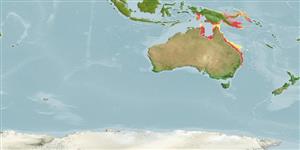>
Clupeiformes (Herrings) >
Engraulidae (Anchovies) > Engraulinae
Etymology: Stolephorus: Greek, stole, -es = garment + Greek, pherein = to carry (Ref. 45335).
Environment: milieu / climate zone / depth range / distribution range
Écologie
marin; saumâtre; profondeur 10 - 13 m. Tropical; 3°S - 32°S, 134°E - 157°E (Ref. 189)
Western Pacific: Gulf of Carpentaria, southern coast of Papua New Guinea; also Moreton Bay near Brisbane, Queensland, Australia.
Length at first maturity / Taille / Poids / Âge
Maturity: Lm 5.0 range ? - ? cm
Max length : 5.0 cm SL mâle / non sexé; (Ref. 189)
Épines dorsales (Total): 0; Épines anales 0; Rayons mous anaux: 19 - 20. Belly with 5 to 7 small needle-like pre-pelvic scutes. Maxilla tip pointed, reaching to or beyond hind border of pre-operculum, the latter concave, indented near maxilla tip. Anal fin origin far forward, below the second to sixth dorsal fin ray bases. The advanced anal fin and the presence of fine teeth on hyoid bones distinguish this species from others in the area.
Presumed coastal, pelagic and schooling. Probably tolerates lowered salinities, judging from the type locality and its occurrence in bays and inlets. Apparently not abundant. More material needed.
Life cycle and mating behavior
Maturité | Reproduction | Frai | Œufs | Fécondité | Larves
Whitehead, P.J.P., G.J. Nelson and T. Wongratana, 1988. FAO Species Catalogue. Vol. 7. Clupeoid fishes of the world (Suborder Clupeoidei). An annotated and illustrated catalogue of the herrings, sardines, pilchards, sprats, shads, anchovies and wolf-herrings. FAO Fish. Synop. 125(7/2):305-579. Rome: FAO. (Ref. 189)
Statut dans la liste rouge de l'IUCN (Ref. 130435)
Menace pour l'homme
Harmless
Utilisations par l'homme
Pêcheries: sans intérêt
Plus d'informations
PaysZones FAOÉcosystèmesOccurrencesIntroductionsStocksÉcologieRégime alimentaireÉléments du régime alimentaireConsommation alimentaireRation
RéférencesAquacultureProfil d'aquacultureSouchesGénétiqueElectrophoresesHéritabilitéPathologiesTraitementNutrientsMass conversion
CollaborateursImagesStamps, Coins Misc.SonsCiguateraVitesseType de nageSurface branchialeOtolithesCerveauxVision
Outils
Articles particuliers
Télécharger en XML
Sources Internet
Estimates based on models
Preferred temperature (Ref.
123201): 24.7 - 29.4, mean 27.7 °C (based on 470 cells).
Phylogenetic diversity index (Ref.
82804): PD
50 = 0.5000 [Uniqueness, from 0.5 = low to 2.0 = high].
Bayesian length-weight: a=0.00537 (0.00253 - 0.01141), b=3.13 (2.96 - 3.30), in cm total length, based on LWR estimates for this (Sub)family-body shape (Ref.
93245).
Niveau trophique (Ref.
69278): 3.2 ±0.4 se; based on size and trophs of closest relatives
Résilience (Ref.
120179): Haut, temps minimum de doublement de population inférieur à 15 mois (K>0.3).
Fishing Vulnerability (Ref.
59153): Low vulnerability (10 of 100).
